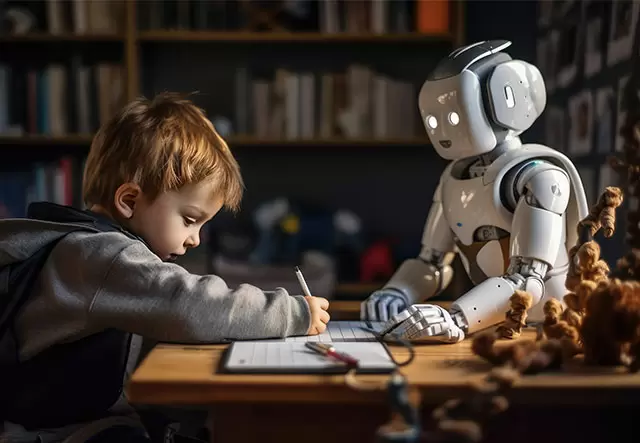In 2025, artificial intelligence is no longer a futuristic concept—it’s a daily presence in classrooms, labs, and training platforms. AI tutors, powered by large language models and adaptive learning algorithms, are helping learners across the world study complex IT concepts at their own pace. They’re available 24/7, offer instant feedback, and are increasingly capable of understanding student emotions and learning patterns.
But with all their sophistication, an important question remains: Can AI tutors truly replace human instructors? Or are they simply enhancing the teaching experience in new and exciting ways?
Let’s explore the rapidly evolving role of AI tutors in IT education, the benefits and limitations they bring, and why the human element still holds its ground.
The Rise of AI Tutors in Education
AI tutors aren’t a new idea, but in 2025, they’ve become far more powerful. Thanks to advancements in natural language processing (NLP), machine learning, and emotional recognition tech, today’s AI tutors can:
- Deliver hyper-personalised learning paths
- Adapt content based on performance
- Provide instant, context-aware feedback
- Simulate conversation and problem-solving scenarios
- Detect when a student is confused or disengaged
Platforms like Squirrel AI, Century Tech, and even newer entries from Microsoft and Google are integrating these tools into virtual classrooms, making high-quality IT instruction more accessible than ever.
What Makes AI Tutors So Appealing?
1. Anytime, Anywhere Learning
Students no longer need to wait for office hours or scheduled classes. AI tutors provide 24/7 support, helping learners debug code, understand cloud infrastructure, or practise cybersecurity concepts on demand.
2. Instant Feedback
AI can analyse student responses in real-time and offer corrective guidance instantly. This speeds up the learning process and reduces frustration—especially in technical subjects where mistakes can compound quickly.
3. Data-Driven Personalisation
AI systems can track student progress, identify weak areas, and modify lesson plans accordingly. This ensures that no two learners have the exact same experience, and each gets what they need to succeed.
4. Scalability
For institutions and training providers, AI tutors offer a scalable solution. One AI system can support thousands of learners without burnout, bias, or inconsistency.
Where AI Still Falls Short
Despite the clear benefits, AI tutors aren’t flawless. In fact, there are areas where the human touch remains irreplaceable:
1. Emotional Intelligence
While AI can mimic empathy, it doesn’t truly understand it. Students facing anxiety, burnout, or life challenges often need genuine human connection—something algorithms can’t replicate.
2. Creativity and Context
IT education isn’t just about memorising commands. It’s about solving real-world problems creatively. Human instructors bring lived experience, industry stories, and spontaneous insights that enrich learning in ways AI cannot.
3. Ethics and Mentorship
Guiding students through ethical decision-making in tech (e.g., data privacy or AI ethics) often requires nuanced discussion and mentorship. This is where human instructors shine.
4. Motivation and Soft Skills
AI can nudge students with reminders, but real motivation—the kind that builds confidence and fosters curiosity—often comes from a passionate teacher or mentor.
How IT Classrooms Are Blending AI and Human Instruction
The future of IT education likely isn’t about replacing teachers with AI. It’s about creating hybrid learning environments that combine the best of both worlds.
Blended Learning in Practice:
- AI handles the basics: Reviewing foundational topics, offering quizzes, tracking progress.
- Humans handle the depth: Leading group discussions, supervising projects, providing mentorship.
- Platforms integrate both: LMS tools like Moodle, Canvas, and Ascend’s own platform are evolving to include AI tutors alongside video lessons and live sessions.
Real-World Story: How One Student Thrived With AI + Human Support
James, a 19-year-old IT student from Ohio, struggled with cloud computing fundamentals. After multiple failed attempts with textbook learning, he turned to an AI tutor on Ascend’s platform. It broke down the material into manageable pieces, gave him targeted feedback, and helped him practise daily.
But it wasn’t until a live session with a human instructor clarified a key concept using a real-world analogy that James finally clicked.
“The AI was great for drilling me on the basics,” he says, “but the instructor gave it meaning. That’s when I felt like I was actually getting it.”
What This Means for Educators in 2025
Educators don’t need to fear AI—they need to collaborate with it. Instructors are shifting roles from content deliverers to learning facilitators and mentors. This means:
- Embracing AI tools as assistants, not competitors
- Focusing on developing student soft skills, creativity, and ethical reasoning
- Using AI-generated data to make better teaching decisions
At Ascend Education, our instructor-led programmes integrate AI-powered tools to personalise learning without replacing our passionate human educators.
Final Thoughts: It’s Not AI vs. Humans. It’s AI + Humans.
The smartest classrooms of 2025 are not teacher-free. They’re tech-enhanced, student-centred environments where AI handles repetition and personalisation, while humans inspire, mentor, and guide.
AI tutors are a breakthrough, not a replacement.
If you’re an educator, learner, or institution leader, now is the time to embrace AI as a tool to amplify learning, not automate it entirely.






